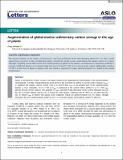Files in this item
Augmentation of global marine sedimentary carbon storage in the age of plastic
Item metadata
| dc.contributor.author | Smeaton, Craig | |
| dc.date.accessioned | 2021-05-18T09:30:34Z | |
| dc.date.available | 2021-05-18T09:30:34Z | |
| dc.date.issued | 2021-06 | |
| dc.identifier | 273035290 | |
| dc.identifier | 28b92066-34fe-49a7-a6c8-692e2ff8c300 | |
| dc.identifier | 000626516500001 | |
| dc.identifier | 85109202134 | |
| dc.identifier.citation | Smeaton , C 2021 , ' Augmentation of global marine sedimentary carbon storage in the age of plastic ' , Limnology and Oceanography Letters , vol. 6 , no. 3 , pp. 113-118 . https://doi.org/10.1002/lol2.10187 | en |
| dc.identifier.issn | 2378-2242 | |
| dc.identifier.other | ORCID: /0000-0003-4535-2555/work/94291658 | |
| dc.identifier.uri | https://hdl.handle.net/10023/23214 | |
| dc.description | Funding: Scottish Alliance for Geoscience, Environment and Society, Natural Environment Research Council (GrantNumber(s): NE/L501852/1). | en |
| dc.description.abstract | Plastic is entering the world's oceans at an unprecedented rate impacting the functioning of the natural marine environment. Yet little consideration has been given to the potential of carbon (C) in the form of plastic (Cplas) to augment the marine carbon system. Here it is shown that Cplas is an integral part of the anthropogenic marine C cycle. Annually, 7.8 ± 1.73 Mt of Cplas is deposited at the seabed with a further 17.2–57.1 Mt Cplas already present on the seafloor. The quantity of Cplas currently being deposited on the seabed annually exceeds the rate at which organic carbon (OC) is buried in some marine sediments and by 2050 it is possible that the rate at which Cplas is buried will match fjord sediments which are global hotspots for OC burial. Though unwanted this new anthropogenic pathway for C to reach the marine environment cannot be ignored. | |
| dc.format.extent | 6 | |
| dc.format.extent | 621802 | |
| dc.language.iso | eng | |
| dc.relation.ispartof | Limnology and Oceanography Letters | en |
| dc.subject | Plastic | en |
| dc.subject | Carbon | en |
| dc.subject | Seabed | en |
| dc.subject | Seafloor | en |
| dc.subject | Burial | en |
| dc.subject | Sediment | en |
| dc.subject | GE Environmental Sciences | en |
| dc.subject | QE Geology | en |
| dc.subject | DAS | en |
| dc.subject | SDG 14 - Life Below Water | en |
| dc.subject.lcc | GE | en |
| dc.subject.lcc | QE | en |
| dc.title | Augmentation of global marine sedimentary carbon storage in the age of plastic | en |
| dc.type | Journal item | en |
| dc.contributor.institution | University of St Andrews. School of Geography & Sustainable Development | en |
| dc.contributor.institution | University of St Andrews. Environmental Change Research Group | en |
| dc.contributor.institution | University of St Andrews. Bell-Edwards Geographic Data Institute | en |
| dc.contributor.institution | University of St Andrews. Scottish Oceans Institute | en |
| dc.identifier.doi | 10.1002/lol2.10187 | |
| dc.description.status | Peer reviewed | en |
This item appears in the following Collection(s)
Items in the St Andrews Research Repository are protected by copyright, with all rights reserved, unless otherwise indicated.

